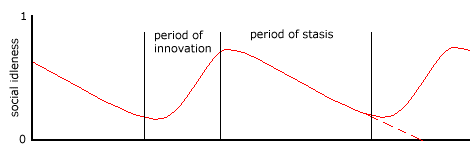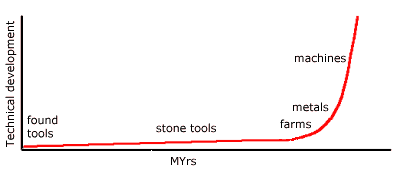
The Rise of the Toolmakers
Ancestral human life, evicted from their forest habitats onto the dry plains of East Africa several million years ago, is regarded in Idle Theory as simply another form of biological life, with no special exemption from the laws that govern all living creatures. Human life is seen as having evolved from pre-human ancestors, and thus to be embedded in natural life, not set apart from it.
In Idle Theory, the overall picture of human evolution is not one of a masterful new species stepping onto the stage of life, but of an outcast species struggling to survive against enormous odds. Early human life is taken to have mostly been a very busy - and short - life, interspersed with easy times when food was abundant and predators scarce.
There are a number of reasons to suppose that life was very difficult for early humans:
- The process of evolution is a rollercoaster ride between highs when life is idle and easy, and lows when it is harsh and difficult. All forms of life are subject to destruction testing during the low times. There is no reason to suppose the human life was exempt from this cyclical threat of extinction.
- When an effective new variant species appears, it is initially more idle than other species, and it survives through a series of crises. But during this period, newer and more effective variants make their appearance, and what had been the latest and idlest variant is overtaken by newer variants. In time, it becomes one of the least idle extant species, and becomes extinct. What is a relatively fast car in 1900 is a relatively slow car in 2000. All species ultimately face extinction.
- Of all the different varieties of hominid forms, only one now survives. All the others are extinct, and in most cases became extinct hundreds of thousands, even millions, of years ago. This suggests that the hominid type in general was not a great success. Until very recently - the past 15,000 years or so, they never existed in large numbers.
- Modern humans do not appear to be adapted to any specialized diet. They are unable to live off leaves and grasses like many ruminants. Neither do they have the speed and power of an effective predator. Humans, it seems, were largely restricted to a diet of high energy roots, nuts, seeds, and the few small animals they were able to catch. Thus for humans, the range of available foods was restricted to a small subset of what was available to browsing or grazing animals, or to predators. This suggests that the search for food kept humans busier than other animals. Life was difficult.
- Humans do not appear to have any effective natural defences against predators. They are relatively slow moving, unarmoured, and without camouflage. Probably humans were subjected to intense predation.
- The relatively rapid development by human bipedalism, and a large brain, as well as language, suggests that humans were subjected to very strong selection pressures. It suggests that those human variants who were quadruped, small-brained, and unable to use language, were at a fatal disadvantage. If not, why aren't they still extant?
The human problem, in short, was the same problem as for all other natural life. Life was frequently difficult, and a great deal of work was needed to survive. Humans were always trying to reduce that work, to increase their idleness, so as to ensure survival.
But the human solution to the problem was an evolutionary departure. Humans began to use tools to assist them in their work. These tools, initially primitive and few in number, gradually became more numerous and sophisticated. The evolution of human life is, substantially, the evolution of human tool systems. The use of tools is not unique to humans, but humans are unique in developing whole systems of tools - technology.
The suggestion, in Idle Theory, is that early humans became tool users very early in their development, and rapidly became completely dependent on these tools for survival. These tools - flint knives and stone hammers, but also body clothing and armour, baskets, ropes, fabrics -, reduced human work, and gave humans a narrow advantage.
Human physical evolution, it is suggested, followed on from human technical innovation:
- The tools - knives, bags, ropes, etc - were hand-held. Human hands became specialized all-purpose tool holders, and ceased to contribute to locomotion. Early humans were carrying tools, food, children in their hands, and walking on their hind legs. Carrying heavy tools forced an erect posture which directed the load down the vertical human spine onto vertical human legs.
- The first tools were probably found objects, but as humans began to manufacture them themselves, they began to require improved hand-eye coordination. The use of these tools also required hand-eye coordination. As numbers of tools increased, humans had to be able to learn quickly how to use many different types of tools. All this required increased motor skills, memory, and intelligence - larger brains.
- Human society, initially loose-knit, became increasingly tightly bound together, with particular individuals taught to make tools, and others to use them. It became essential for humans to develop language skills to communicate detailed ideas in an increasingly ordered society.
Human society was primarily a tool system. Knives and hatchets enabled humans to cut and clear much more rapidly than with bare hands. Bags enabled them to carry more than they could with their hands. Ropes allowed them to bind together more than their arms could hold. These prosthetic devices, although physically separate, were integral to human society. Without these tools, the tasks required for survival could not possibly have been carried out, and humans would have become extinct.
The tool system defined human morality and human social organization. The tools had to be made in the right way, and used in the right way at the right time, and kept in good repair. Society had to be organized to ensure that tool shortages were avoided, and to distribute tools to those who needed them when they needed them. What was right was what was expeditious - whatever speeded work, and raised idleness.
The tool system had to be continually developed and improved in order to maintain the slender human life advantage. Simply making a few stone tools may have served well enough a few megayears ago, but changing circumstances (e.g. ice ages) required increasingly effective, durable, versatile and easily-made tools.
There was probably a regular tool development cycle. Human technical and social innovation would increase human idleness, possibly to high levels. But in the most idle societies, further innovation brings diminishing returns in the form of increased idleness. The cost of innovation ceases to be justified by the returns it brings. In such societies, innovation slows or stops. Society thereafter tends to conduct itself in a traditional manner, with a rigid, even ossifying political organization, and an unchanging technology. But if, at the same time, the circumstances of such a society are deteriorating, social idleness will gradually fall, and will continue to fall until new technical and social innovations increase social idleness. Thus, rather than innovation proceeding continuously, it is more likely to proceed cyclically, in periodic bursts.

The catalogue of human innovations must also be the catalogue of the disasters which overtook humans, and forced them to innovate again and again. The development of language, of tools, of complex social organizations, were successful last ditch attempts to avert disaster. All these innovations were attempts to make life easier in the face of increasing difficulty. Those early humans which didn't develop these abilities simply didn't survive.
The tool system gave humans great flexibility in their response to changing circumstances. Most animals have, as it were, their tools built into their physiology, in the form of teeth, claws, pincers, etc. Human tools allowed humans to at one time hold spades, at other times to hold swords, and again to hold paddles, as circumstances required.
This picture of human evolution is largely one of cultural evolution, rather than genetic change. Modern humans are not much different, anatomically, from their smaller ancestors. Human evolution did not involve the development, through genetic mutation, of wings or fins or unusual new organs, but of tools and techniques. Humans became the all-purpose handles into which any number of tools - from hoes and spades to swords and pens - could be slotted. The handle didn't change much, but the tools changed continually. If anything, the human handle probably gradually lost its native abilities, in acuity of hearing, smell, and sight, prehensile feet (and possibly tails), along with its covering of fur. The human survivors of natural disasters were not necessarily genetic improvements on non-survivors, but cultural improvements - able, for example, to weave textiles or make clay pots, skills unknown to other human societies, and critical for making warm garments and storing food or water. In its discussions of human life, Idle Theory therefore largely discounts genetic dispositions.
Repeated technological development and social reorganization served to maintain human social idleness at or above survival levels. For a long time, the pace of development was slow. But the steady accumulation of skills began to take on explosive exponential growth in recent human history - the last 20,000 years or so -. In that time, humans developed farms, bred grasses, domesticated animals, smelted copper, tin, and iron. The pace of technological development quickened. More recently still - in the past 500 years - the pace of technological development has accelerated with every century, bringing whole families of machine tools, mass transport systems, aircraft, radio and television, and, critically, new energy sources in the form of coal, oil, and nuclear power.

The consequent increased human idleness has been mostly converted into increased human population. From a global population of some few millions 20,000 years ago, human numbers have now risen about a thousandfold to several billions.
The increased human idleness generated by technology has also allowed humans to develop idle-time cultural activities. It has allowed them to write literature, poetry, perform plays, play varieties of games, converse, think, study. And now a great deal of human work is directed towards producing luxuries and amusements which do not serve in any way to increase human idleness.
This brief picture of human evolution from untooled ape to supertooled civilization is one of driving necessity. Humans had to develop tools, simply to survive. They had to continually develop and improve those tools. They had to organize their societies to teach people how to make and distribute and use these tools. Human society, repeatedly facing extinction, used its technology to pull itself up by its own bootstraps, and give itself the breathing space of some degree of leisure. The primary goal of human society has always been to liberate itself from work.
